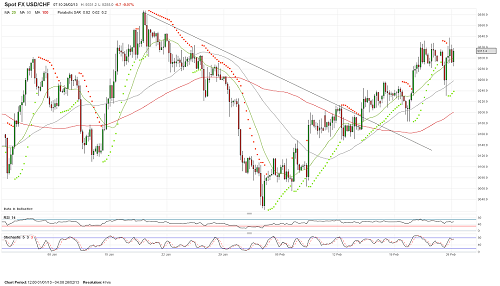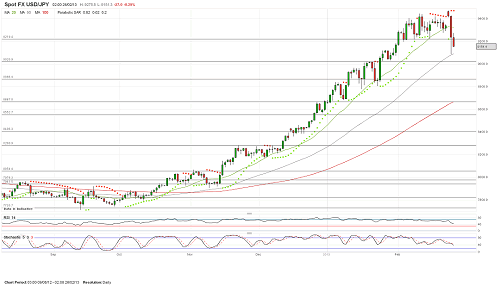By Bill Bonner
Planet Earth dodged a bullet last week. A meteorite exploded over Siberia… knocking out roofs and windows… and injuring hundreds.
“Doomsday!” said an old woman who saw the explosion.
Another meteor or asteroid passed within 17,000 miles of Indonesia. Scientists said they had been keeping an eye on it.
We interrupt this brush with the End-of-the-World for a quick market update. Yesterday, the Dow plunged 108 points. And gold plummeted $26/oz. As I type, the yellow metal is selling for $1,569/oz. Is this the end of the line for the secular gold bull market that began in 1998?
We don’t know… but we’re hoping to see the price of gold fall to $1,000 — or lower. Then we’ll buy as much as we can afford!
Meanwhile, scientists are keeping an eye on the planet’s weather. It’s getting much warmer… or much colder… depending on whom you talk to.
The “much warmer” crowd has the microphone in its hand. Led by Al Gore and others. It is convinced that greenhouse gases are turning Earth into a raging inferno.
Carbon dioxide is the main culprit. There’s always carbon dioxide in the air. It is what you get when carbon-based elements — living things — decompose. You also get heat energy. You can test this yourself. Just put your hand into a pile of decomposing leaves… or hay… or manure. You’ll find it warm. Which is why burning formerly living things is so popular. That’s how we warm our hands… power our drones… and run our automobiles.
The Argument for Global Warming
Here we give you a simple explanation of the argument for global warming, as we understand it.
The sun hits the Earth. Some of the light is reflected back to space, especially the light that falls on shiny white surfaces — such as the South Pole. Much of the light is absorbed… as heat… by the oceans, dirt and so forth. And much of it is absorbed by plants and turned from solar energy into carbon-based life. That’s how we live. Some things live on the sun’s light — along with water and nutrients from the air or soil. Other things eat them. And still other things eat the things that eat the plants.
Trees grow. You can cut them down and burn them for firewood, releasing heat… and carbon dioxide. But if you burn a tree, you add little to the world’s carbon dioxide,
because the tree would have died and released its carbon dioxide into the air anyway… though over a longer period of time.
Over the eons much of the sun’s energy was captured in plants that didn’t fully decompose. Instead, they then sank into swamps… and were compressed into coal,
oil and gas. Burning this “fossil fuel” is different from burning a tree. Because it releases millions of years’ worth of the sun’s energy… and also billions of tons of carbon dioxide that was “locked up” in the ground.
A Bullet Heading for Earth?
In all the years that Earth has been in existence there have been many collisions with meteors and asteroids. There have been dramatic changes in the Earth’s climate too.
But never before has an animal figured out how to use this stored-up solar energy. And never before has an animal significantly altered the amount of carbon dioxide in the atmosphere… and potentially altered the Earth’s climate.
Is this true? Does it make any difference? Is climate change another huge bullet headed for planet Earth?
We don’t know. Many smart people believe it. No one knows for sure.
A friend sent a serious book on the issue: High Tide on Main Street, by John Englander. It is not so much concerned with trying to change or protect the world’s climate as it is with what is likely to happen and how it will affect our lives. Englander writes:
The last truly abrupt
changes in the Earth’s climate occurred more than 50 million years ago.
During that period, carbon dioxide increased about 100 ppm over a
million years. The global temperature spiked by about 9 degrees F […]
over 10,000 years. While that may sound slow, in geologic time it is
considered quick and drastic.At our current rate of
carbon emissions, we will increase carbon dioxide levels by that same
100ppm in just 30 to 40 years. In other words, we are increasing carbon
dioxide levels roughly 20,000 times faster than at any time in the last
540 million years. Temperatures, which can lag behind the rise of carbon
dioxide, are now rising about 55 times faster than they did even during
the most recent cycle of glacial melting.
Rising Seas
Are human beings to blame? Perhaps. Perhaps not. But if Englander is right, this is a bullet we may not be able to sidestep.
And it could surprise us all by how fast it comes at us. Methane, says Englander, is the wild card. It’s the most effective of the greenhouse gases — meaning, it traps
more heat than any other.
There is beaucoup methane locked up in now melting permafrost — billions of tons of it. This methane… and the unprecedented levels of carbon dioxide… could cause a runaway heat effect — something that has never happened before either. This, in turn, could cause the Earth’s water level to rise — fast.
A few years ago, the local Baltimore papers carried an article about an island in the nearby Chesapeake Bay. Holland Island had been the home of several families.
They farmed. They fished. They built large, handsome houses and enjoyed life — for generations — in “the land of pleasant living.”
But then the islands sank. Or rather the water rose. Sharps Island — 900 acres, with several farms, houses and a hotel — disappeared in 1962. Holland Island was underwater
by 2010. Its last resident waited until the water was at his door. Then he waded to a boat and said goodbye.
Englander believes that present trends will raise water levels some 212 feet. When? He doesn’t know. This has never happened before, he says.
Say goodbye to much of India… China… Bangladesh… the Phillipines… the Netherlands… Florida… and Nigeria. And if you are buying waterfront property, you may want to look at property about 200 feet above sea level. Anything lower than that may soon be underwater.
Regards,

Bill




